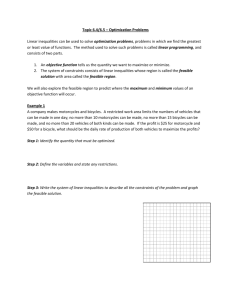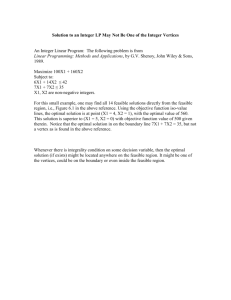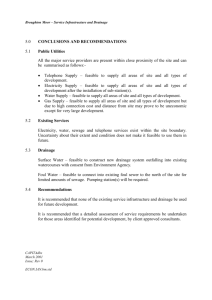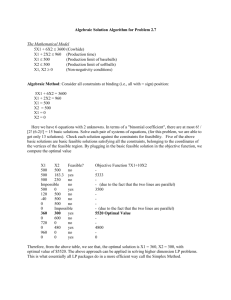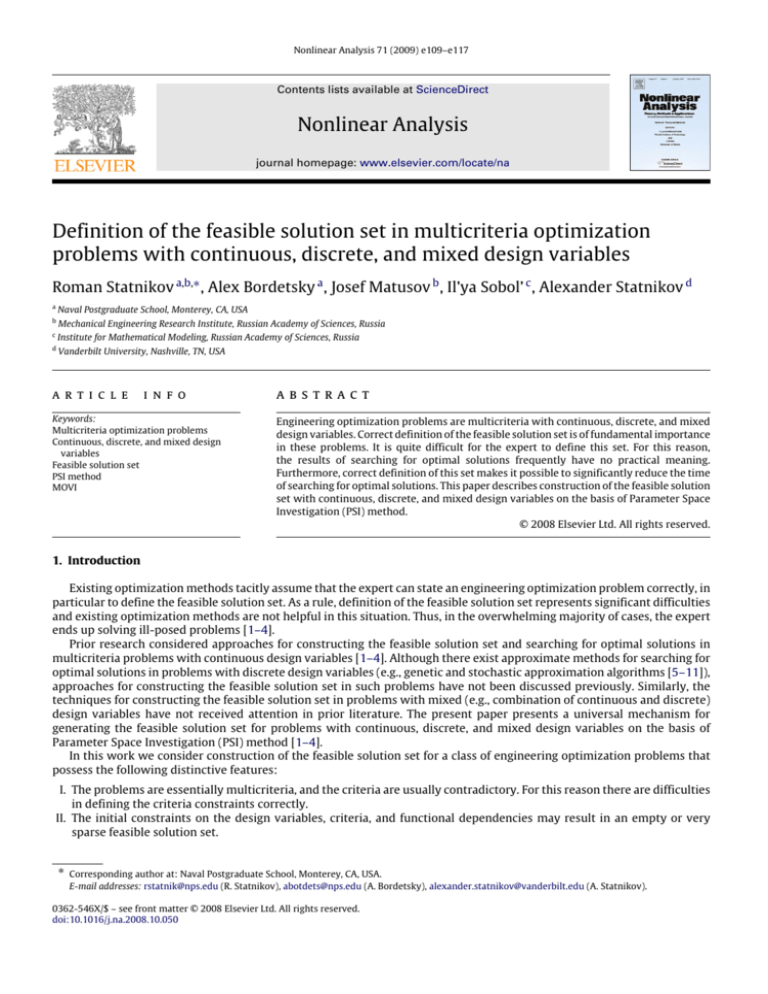
Nonlinear Analysis 71 (2009) e109–e117
Contents lists available at ScienceDirect
Nonlinear Analysis
journal homepage: www.elsevier.com/locate/na
Definition of the feasible solution set in multicriteria optimization
problems with continuous, discrete, and mixed design variables
Roman Statnikov a,b,∗ , Alex Bordetsky a , Josef Matusov b , Il’ya Sobol’ c , Alexander Statnikov d
a
Naval Postgraduate School, Monterey, CA, USA
b
Mechanical Engineering Research Institute, Russian Academy of Sciences, Russia
c
Institute for Mathematical Modeling, Russian Academy of Sciences, Russia
d
Vanderbilt University, Nashville, TN, USA
article
info
Keywords:
Multicriteria optimization problems
Continuous, discrete, and mixed design
variables
Feasible solution set
PSI method
MOVI
abstract
Engineering optimization problems are multicriteria with continuous, discrete, and mixed
design variables. Correct definition of the feasible solution set is of fundamental importance
in these problems. It is quite difficult for the expert to define this set. For this reason,
the results of searching for optimal solutions frequently have no practical meaning.
Furthermore, correct definition of this set makes it possible to significantly reduce the time
of searching for optimal solutions. This paper describes construction of the feasible solution
set with continuous, discrete, and mixed design variables on the basis of Parameter Space
Investigation (PSI) method.
© 2008 Elsevier Ltd. All rights reserved.
1. Introduction
Existing optimization methods tacitly assume that the expert can state an engineering optimization problem correctly, in
particular to define the feasible solution set. As a rule, definition of the feasible solution set represents significant difficulties
and existing optimization methods are not helpful in this situation. Thus, in the overwhelming majority of cases, the expert
ends up solving ill-posed problems [1–4].
Prior research considered approaches for constructing the feasible solution set and searching for optimal solutions in
multicriteria problems with continuous design variables [1–4]. Although there exist approximate methods for searching for
optimal solutions in problems with discrete design variables (e.g., genetic and stochastic approximation algorithms [5–11]),
approaches for constructing the feasible solution set in such problems have not been discussed previously. Similarly, the
techniques for constructing the feasible solution set in problems with mixed (e.g., combination of continuous and discrete)
design variables have not received attention in prior literature. The present paper presents a universal mechanism for
generating the feasible solution set for problems with continuous, discrete, and mixed design variables on the basis of
Parameter Space Investigation (PSI) method [1–4].
In this work we consider construction of the feasible solution set for a class of engineering optimization problems that
possess the following distinctive features:
I. The problems are essentially multicriteria, and the criteria are usually contradictory. For this reason there are difficulties
in defining the criteria constraints correctly.
II. The initial constraints on the design variables, criteria, and functional dependencies may result in an empty or very
sparse feasible solution set.
∗
Corresponding author at: Naval Postgraduate School, Monterey, CA, USA.
E-mail addresses: rstatnik@nps.edu (R. Statnikov), abotdets@nps.edu (A. Bordetsky), alexander.statnikov@vanderbilt.edu (A. Statnikov).
0362-546X/$ – see front matter © 2008 Elsevier Ltd. All rights reserved.
doi:10.1016/j.na.2008.10.050
e110
R. Statnikov et al. / Nonlinear Analysis 71 (2009) e109–e117
III. The feasible solution set can be multiply connected, and its volume may be several orders of magnitude smaller than
that of the domain where the optimal solutions are sought. Generally, the feasible solution set is non-convex.
IV. Mathematical models are often complex systems of equations (including differential equations) that may be nonlinear,
deterministic or/and stochastic, with distributed, lumped, continuous, discrete, and mixed design variables. Information
about the smoothness of goal functions is usually not available.
V. In this class of problems, experts do not encounter difficulties in analyzing the Pareto optimal set and choosing the most
preferred solution. This is because experts have a sufficiently well-defined system of preferences1 and the Pareto optimal
set often contains a small number of solutions due to stringent constraints.
The remainder of this paper is organized as follows: In Sections 2–4 we provide definition of the feasible solution set and
approaches for its construction. Tools for visualization that are instrumental for construction of the feasible solution set are
described in Section 5. Examples with continuous, discrete, mixed design variables are described in Sections 6 and 7. The
paper concludes with Section 8.
2. Formulation of multicriteria optimization problem
We assume that an object depends on r design variables α1 , . . . , αr representing a point α = (α1 , . . . , αr ) in the rdimensional space. In the general case, one has to take into account design variable, functional, and criteria constraints. The
design variable constraints have the form αj∗ ≤ αj ≤ αj∗∗ , j = 1, . . . , r. Constraints αj∗ and αj∗∗ define a parallelepiped Π in
the r-dimensional design variable space. The functional constraints can be written as follows: Cl∗ ≤ fl (α) ≤ Cl∗∗ , l = 1, . . . , t,
where fl (α) is a functional relation, Cl∗ and Cl∗∗ are some constants. The operation of an object is described by the particular
performance criteria Φν (α), ν = 1, . . . , k. All other things being equal, it is desired that these criteria are optimized. For
simplicity, we assume that functions Φν (α) are to be minimized. To avoid situations in which the expert regards the values
of some criteria as unacceptable, we introduce criteria constraints in the form Φν (α) ≤ Φν∗∗ , ν = 1, . . . , k, where Φν∗∗ is the
worst value of criterion Φν (α) acceptable to an expert. The choice of Φν∗∗ is discussed in the following section. The design
variable, functional, and criteria constraints define the feasible solution set D ⊂ Π .
3. Construction of feasible solution set on the basis of Parameter Space Investigation (PSI) method
We propose to construct the feasible solution set using the PSI method that is based on the investigation of parallelepiped
Π with α i points of uniformly distributed sequences. The method is extensively described in [1–4], and here we present only
its summary. The PSI method consists of three stages:
Stage 1: Compilation of test tables via computer. First, one chooses N trial points α 1 , . . . , α N that satisfy the functional
constraints. Then all the particular criteria Φν(α i ) are calculated
at each of the points α i ; and for each of the criteria a test
table is compiled so that the values of Φν α 1 , . . . Φν α N are arranged in increasing order, i.e.
Φν α i1 ≤ Φν α i2 ≤ · · · ≤ Φν α iN ,
ν = 1, . . . , k,
(1)
where i1 , i2 , . . . , iN are the numbers of trials (a separate set for each ν ). Taken together, the k tables form a complete test
table.
Stage 2: Preliminary selection of criterion constraints. This stage includes interaction with an expert. By analyzing inequalities
(1), an expert specifies the criteria constraints Φν∗∗ . An expert analyzes one test table and imposes the criterion constraint.
Then one proceeds to the next table, and so on. Note that the revision of the criteria constraints within the limit of the test
tables does not lead to any difficulties for an expert.
Since we want to minimize all criteria, Φν∗∗ are the maximum values of the criteria Φν (α), which guarantee an acceptable
level of the object’s operation. If the selected values of Φν∗∗ are not a maximum, then many interesting solutions may be
lost, since some of the criteria are contradictory. As a rule, an expert may set Φν∗∗ equal to a criterion value Φν (α) whose
feasibility is beyond doubt. However, if one starts by determining the maximum possible value of Φν∗∗ then one has to
proceed to Stage 3.
Stage 3: Verification that the set D is non-empty. Let us fix a criterion, say Φν1 (α), and consider the corresponding test table
(2). Let S1 be the number of the values in the table satisfying the selected criterion constraint:
Φν1 α i1 ≤ · · · ≤ Φν1 α iS1 ≤ Φν∗∗1 = Φν1 (α) .
(2)
One should choose the criterion Φν1 for which S1 is the minimum among the analogous numbers calculated for each of the
i
criteria Φν . Then criterion Φν2 is selected by analogy with Φν1 and the values of Φν2 α i1 , . . . , Φν2 α S1 in the test table are
, where 1≤ j ≤ S2 . Similar procedures are carried
considered. Let the table contain S2 ≤ S1 values such that Φν2 α ij ≤ Φν∗∗
2
out for each criterion. Then if at least one point can be found for which all criteria constraints are valid simultaneously, then
1 More complex cases of the decision making, where preferences are not necessarily stable on the Pareto optimal set are discussed in [16].
R. Statnikov et al. / Nonlinear Analysis 71 (2009) e109–e117
e111
the set D is non-empty. However, if the concessions are highly undesirable, then one may return to Stage 1 and increase the
number of points in order to repeat Stage 2 and Stage 3 using extended test tables.
The majority of constraints on functional dependencies Cl∗ and Cl∗∗ are ‘‘soft’’, i.e. they can be changed. If functional
constraints are poorly specified, this can considerably reduce the feasible solution set. Therefore, many interesting solutions
become unreasonably unfeasible. Furthermore, the feasible solution set can be empty. For this occasion, we represent
the functional dependencies with ‘‘soft’’ constraints in the form of so-called pseudo-criteria. Thus, criteria vector contains
both performance criteria and pseudo-criteria. The PSI method helps to define pseudo-criteria constraints with respect to
improving the performance criteria.
The PSI method is implemented in the MOVI (Multicriteria Optimization and Vector Identification) software system [12].
4. Uniformly distributed sequences in the problems with continuous, discrete, and mixed design variables
As mentioned above PSI method uses uniformly distributed sequences to investigate design variable space. At present,
the so-called LPτ sequences are among the best ones in terms of uniformity characteristics. We note that other generators,
including the random number generators, are used as well in the PSI method.
Below we describe approaches for generating uniform sequences in the problems with continuous, discrete, and mixed
design variables.
Continuous design variables: If points Qi i = 1, . . . , N with Cartesian coordinates (qi1 , . . . , qir ) form a uniformly
distributed sequence in unit cube K r , then points α i , with coordinates α1i , . . . , αri , where
αji = αj∗ + q ij (αj∗∗ − αj∗ ),
j = 1, 2, . . . , r ,
form a uniformly distributed sequence in parallelepiped π consisting of points (α1 , . . . , αr ) whose coordinates satisfy
inequalities αj∗ ≤ αj ≤ αj∗∗ [1–4]. Points Qi can be independent random numbers as well.
Discrete design variables: First we introduce an extension of the definition of objective function that substantiates
application of the PSI method in problems with discrete design variables.
Consider the objective function f (x, z ), where point x belongs to an n-dimensional parallelepiped Π , and the design
variable z is discrete and may take m values: {ẑ1 , . . . , ẑm }. We extend the definition of f (x, z ) to all possible z from the
interval 0 ≤ z < 1. Let k = 1, 2, . . . , m. If
k−1
k
≤z< ,
m
m
then we will consider that
f (x, z ) = f x, ẑk .
(3)
(4)
Thus, the objective function is defined in the (n + 1)-dimensional parallelepiped Π × [0, 1). For the value of z we choose
the (n + 1)th coordinate of a quasi-random point (q1 , q2 , . . . , qn+1 ) (or an independent random number). According to [15],
the value of k from (3) may be defined by the formula k = 1 + [mqn+1 ]. This value of k should be used in (4). It is evident
that the frequency of appearance of ẑk in (4) is equal to 1/m for each k.
Mixed design variables: Mixed design variables are α i = (αji , ẑki ), where j = 1, . . . , n indices continuous and k =
n + 1, . . . , r indices discrete design variables. The treatment of continuous and discrete design variables is analogous to
the above description.
5. Tools for visualization
Below we describe a few visualization tools that are particularly useful for construction of the feasible solution set [13].
It is important to emphasize that these tools should be used together with the test tables. All the tools2 listed below are
implemented in the software system MOVI.
• Histograms of the distribution of feasible solutions. The intervals [αj∗ ; αj∗∗ ], j = 1, . . . , r are divided into ten identical
subintervals. Above each subinterval, the number of feasible designs entering this subinterval is indicated. Analyzing the
histograms reveals how the feasible solution set is distributed in design variable space. The histograms play the main
role in correcting design variable and other constraints.
• Graphs ‘‘Criterion vs. Design Variable.’’ We consider projections of the multidimensional points Φν α i , ν = 1, . . . , k, i =
1, . . . , N1 onto the plane Φν αj . These projections provide information about the sensitivity of criteria to the design
variables, and also point to localization of the feasible solution set. Significance of the sensitivity of criteria to the design
variables is indicated in [14].
• Graphs ‘‘Criterion vs. Criterion’’. After N tests, N1
design variable vectors have entered the test table. We consider
projections of the multidimensional points Φν α i ,ν = 1, . . . , k, i = 1, . . ., N1 onto the plane Φi Φj . These projections
provide information about dependencies between criteria and localization of the feasible solution set in criteria space.
The examples of application of the above tools are provided in the next section.
2 In this paper we describe only a few basic tools. A detailed description of other tools, e.g. tables of functional and criteria failures, tables of criteria, is
provided in [13].
e112
R. Statnikov et al. / Nonlinear Analysis 71 (2009) e109–e117
Table 1
Inequalities (6), (6a) and (6b) that define design variable constraints.
Continuous design variables (6):
Example I
Discrete design variables (6a):
Example II
Mixed design variables (6b):
Example III
1.1 × 106 ≤ α1 ≤ 2.0 × 106
α1 = {1.1 × 106 ; 1.3 × 106 ; 1.5 × 106 ; 1.7 ×
106 ; 1.8 × 106 ; 2.0 × 106 }
α2 = {4.0 × 104 ; 4.3 × 104 ; 4.7 × 104 ; 4.8 ×
104 ; 4.9 × 104 ; 5.0 × 104 }
α3 = {950; 970; 980; 990; 1000; 1040; 1050}
α4 = {30; 32; 37; 40; 45; 50; 60; 70}
α5 = {80; 85; 90; 95; 100; 105; 120}
α1 = {1.1 × 106 ; 1.3 × 106 ; 1.5 × 106 ;
1.7 × 106 ; 1.8 × 106 ; 2.0 × 106 }
α2 = {4.0 × 104 ; 4.3 × 104 ; 4.7 × 104 ;
4.8 × 104 ; 4.9 × 104 ; 5.0 × 104 }
950 ≤ α3 ≤ 1050
30 ≤ α4 ≤ 70
80 ≤ α5 ≤ 120
4.0 × 104 ≤ α2 ≤ 5.0 × 104
950 ≤ α3 ≤ 1050
30 ≤ α4 ≤ 70
80 ≤ α5 ≤ 120
6. Definition of the feasible solution set
This section shows the process of definition of the feasible solution set by an example. Consider the motion of system
governed by the following equations:
M1 X100 + C (X10 − X20 ) + K1 X1 + K2 (X1 − X2 ) = P · cos(ωt )
(5)
M2 X200 + C (X20 − X10 ) + K2 (X2 − X1 ) = 0.
The mass M1 is attached to a fixed base by a spring with stiffness coefficient K1 . A spring-and-dashpot element with stiffness
coefficient K2 and damping coefficient C is located between masses M1 and M2 . The harmonic force acts upon mass M1 . The
amplitude and frequency of the exciting force are identified as P = 2000 (N) and ω = 30 (s−1 ). We treat parameters K1 ,
K2 , M1 , M2 , and C as the design variables to be determined, i.e.: α1 = K1 (N/m); α2 = K2 (N/m); α3 = M1 (kg); α4 =
M2 (kg); α5 = C (N s/m). The design variable constraints are defined as the parallelepiped Π defined by the inequalities
(6), (6a) and (6b) shown in Table 1. There are three functional dependencies with five constraints (on the total mass and on
the partial frequencies):
f1 (α) = α3 + α4 ≤ 1100.0 kg;
α1 /α3 ≤ 42.0 s−1 ;
p
27.0 ≤ f3 (α) = p2 = α2 /α4 ≤ 32.0 s−1 .
33.0 ≤ f2 (α) = p1 =
p
(7)
An expert provides the following recommendations: Values of design variable and functional constraints can be changed,
if that leads to the improving the main criteria.
The upper limits on the functions f2 and f3 are defined approximately and can be significantly modified. In other words,
these are two ‘‘soft’’ functional constraints f2 (α) ≤ 42.0, f3 (α) ≤ 32.0. The rest of functional constraints f1 (α) ≤
1100.0;33.0 ≤ f2 (α); 27.0 ≤ f3 (α) are rigid.
Taking into account these considerations, we formulate the optimization problem as follows.
Criteria: According to the PSI method, in order to define ‘‘soft’’ constraints on functional relations f2 and f3 , the latter
should be interpreted as the pseudo-criteria, i.e. Φ1 = f2 and Φ2 = f3 . The system is to be minimized with respect to the
following four performance criteria:
• Φ3 = X1∂ mm—vibration amplitude of the first mass;
• Φ4 = M1 + M2 kg—metal consumption of the system;
• Φ5 = X1∂ /X1st —dimensionless dynamical characteristic of the system, where X1st is the static displacement of mass M1
under the action of the force P;
• Φ6 = ω/p1 —dimensionless dynamical characteristic of the system.
Thus, we have a vector of criteria Φ = (Φ1 , Φ2 , Φ3 , Φ4 , Φ5 , Φ6 ), on the basis of which test tables are constructed and
criteria constraints are defined.
Design variables: There are five design variables: α = (α1 , α2 , α3 , α4 , α5 ) that can either be continuous (Example I),
discrete (Example II), or mixed (the first and second design variables are discrete; third, fourth, and fifth are continuous)
(Example III) as described in Table 1.
Functional constraints: As mentioned above, we have three rigid functional constraints.
Criteria constraints: We define criteria constraints on the basis of the PSI method:
Φ1∗∗ = 35.20;
Φ2∗∗ = 36.98;
Φ3∗∗ = 8.40;
Φ4∗∗ = 1019;
Φ5∗∗ = 18.11,
and Φ6∗∗ = 0.9.
(8)
R. Statnikov et al. / Nonlinear Analysis 71 (2009) e109–e117
e113
Fig. 1. Histograms.
Notice that constraints (6), (7) and (8) define the feasible solution set for Example I; constraints (6a), (7) and (8) define
the feasible solution set of Example II; and constraints (6b), (7) and (8) define the feasible solution set of Example III.
e114
R. Statnikov et al. / Nonlinear Analysis 71 (2009) e109–e117
Fig. 2. Graphs ‘‘Criterion vs. Design Variable’’.
R. Statnikov et al. / Nonlinear Analysis 71 (2009) e109–e117
Fig. 3. Graphs ‘‘Criterion vs. Criterion’’
e115
e116
R. Statnikov et al. / Nonlinear Analysis 71 (2009) e109–e117
Table 2
Location of the feasible solutions.
Problems
First design variable
Second design
variable
Third design
variable
Forth design
variable
Fifth design variable
Continuous design variables:
Example I
Discrete design variables: Example II
Mixed design variables: Example III
[1.1 × 106 ; 1.18 ×
106 ]
1.1 × 106
1.1 × 106
[4.0 × 104 ; 5.0 ×
104 ]
4.0 × 104 ; 5.0 × 104
4.0 × 104 ; 5.0 × 104
[950; 975]
[42.2;61]
[81.4;120]
950; 970
[950; 975]
45; 60
[42.2; 65.7]
80; 120
[82.9; 120]
7. Results
We performed N = 4096 tests in each of the three examples and obtained 24, 24, and 38 feasible solutions, respectively.
The location feasible solution is shown in Table 2, histograms (Fig. 1), graphs ‘‘Criterion vs. Design Variable’’ (Fig. 2),3 and
graphs ‘‘Criterion vs. Criterion’’ (Fig. 3).4 In the above figures, the area with feasible solutions is shown with red circle or
polygon; the unfeasible solutions are shown with magenta points in Figs. 2 and 3. Similar results were obtained for N = 2048
and N = 8192 tests (not shown here for brevity).
In cases with continuous, discrete, and mixed design variables, there is the same tendency of location of the feasible
solution set, regardless of the types of design variables. From the histograms in Fig. 1 it follows that localization of feasible
solutions occurs at the left-hand limits for the first and third design variables, at the midpoint of the interval for the fourth
design variable, while for the fifth design variable, feasible solutions are distributed throughout the entire interval. The
nature of the dependencies of criteria on design variables (Fig. 2) and of criteria on criteria (Fig. 3) is nearly identical for all
three cases. The location of the feasible solutions on these graphs is also very similar.
From the example with continuous design variables (Example I), it follows that the volume of the feasible solution
set is ∼40 times smaller than the volume of the initial parallelepiped; see (6) and Table 2. The initial statement of the
problem, including limits of the design variables, is usually corrected on the basis of analysis of the resulting feasible
solution set. This in turn almost always leads to an improvement in obtained results [13]. Specifically, for the first, third,
and fourth design variables, this can mean a revision of the initial limits (6) and generation of new limits, for example,
1.0 × 106 ≤ α1 ≤ 1.18 × 106 , 950 ≤ α3 ≤ 975, and 42.2 ≤ α4 ≤ 61; see Table 2 and Fig. 1. The same also holds for
problems with discrete and mixed design variables (i.e., Examples II and III).
Analysis of criteria vs. design variable and criteria vs. criteria dependencies (Figs. 2 and 3) provides valuable information
on the sensitivity of criteria to design variables and on the relationships between criteria. For example, from analysis of
graphs in Fig. 2 it follows that there is a linear dependence of the first criterion on the first design variable, there is a fairly
complex relation between the second criterion and the first design variable, and so on. From Fig. 3 it follows that the first
and sixth criteria are linearly dependent but antagonistic, there is a complex relation between the first and second criteria,
and so on. This analysis, like an analysis of the histograms, facilitates correction of the initial statement of the problem.
8. Conclusion
Due to the difficulties in defining the feasible solution set, it is often impossible in the engineering problems to perform
a search for optimal solutions or it is often performed ineffectively. In a number of cases, the search for optimal solutions
requires an unjustifiably large computing experiment, and the results of the optimization have no applied significance. The
PSI method has proved its effectiveness in constructing the feasible solution set in multicriteria problems with continuous,
discrete, and mixed design variables. The results presented here show the expediency of using the PSI method for defining
the feasible solution set regardless of the nature of the design variables.
References
[1]
[2]
[3]
[4]
[5]
[6]
[7]
[8]
R.B. Statnikov, J.B. Matusov, Multicriteria Analysis in Engineering, Kluwer Academic Publishers, Dordrecht, Boston, London, 2002.
R.B. Statnikov, J.B. Matusov, Multicriteria Optimization and Engineering, Chapman & Hall, New York, 1995.
I.M. Sobol’, R.B. Statnikov, Selecting Optimal Parameters in Multicriteria Problems, 2nd ed., Drofa, Moscow, 2006, (in Russian).
R.B. Statnikov, J. Matusov, Use of Pτ nets for the approximation of the Edgeworth–Pareto set in multicriteria optimization, Journal of Optimization
Theory and Applications 91 (3) (1996) 543–560.
T. Back, Evolutionary Algorithms in Theory and Practice, Oxford University. Press, New York, 1996.
M.R. Ghasemi, E. Hinton, R.D. Wood, Optimization of trusses using genetic algorithms for discrete and continuous variables, Engineering Computations
16 (3) (1999) 272–303.
C.-Y. Lin, P. Hajela, Genetic algorithms in optimization problems with discrete and integer design variables, Engineering Optimization 19 (4) (1992)
309–327.
S. Gunawan, P.Y. Papalambros, Reliability optimization with mixed continuous–discrete random variables and parameters, Journal of Mechanical
Design 129 (2) (2007) 158–165.
3 In Fig. 2, the values of parameters (design variables) and criteria are shown on the horizontal and vertical axes, respectively.
4 In Fig. 3(a), (b), and (c) the value of criterion 1 is shown on the horizontal axis; in Fig. 3(d) the value of criterion 3 is shown on the horizontal axis;
values of the rest of the criteria are shown on the vertical axis.
R. Statnikov et al. / Nonlinear Analysis 71 (2009) e109–e117
e117
[9] S. Bhatnagar, H.J. Kowshik, A discrete parameter stochastic approximation algorithm for simulation optimization, Simulation 81 (11) (2005) 757–772.
[10] W.R. Lee, V. Rehbock, L. Caccetta, K.L. Teo, Numerical solution of optimal control problems with discrete-valued system parameters, Journal of Global
Optimization 23 (3–4) (2002) 233–244.
[11] D. Yan, H. Mukai, Stochastic discrete optimization, SIAM Journal of Control and Optimization 30 (3) (1992) 594–612.
[12] I.V. Yanushkevich, R.B. Statnikov, A.R. Statnikov, J.B. Matusov, Software Package MOVI 1.3 for Windows: User’s Manual, 2005.
[13] R. Statnikov, A. Bordetsky, A. Statnikov, Multicriteria analysis tools in real-life problems, Journal of Computers and Mathematics with Applications 52
(1–2) (2006) 1–32.
[14] I.M. Sobol’, Global sensitivity indices for nonlinear mathematical models and their Monte Carlo estimates, Mathematics and Computers in Simulation
55 (1–3) (2001) 271–280.
[15] I.M. Sobol’, A Primer for the Monte Carlo Method, CRC Press, 1994.
[16] S. Lichtenstein, P. Slovic, The Construction of Preference, Cambridge University Press, 2006.



